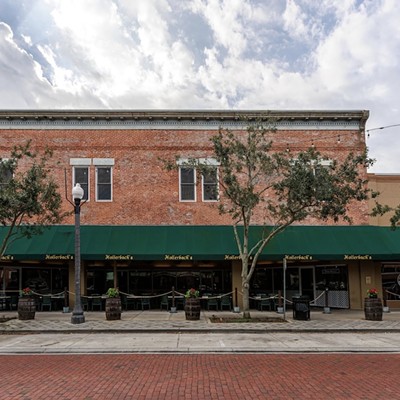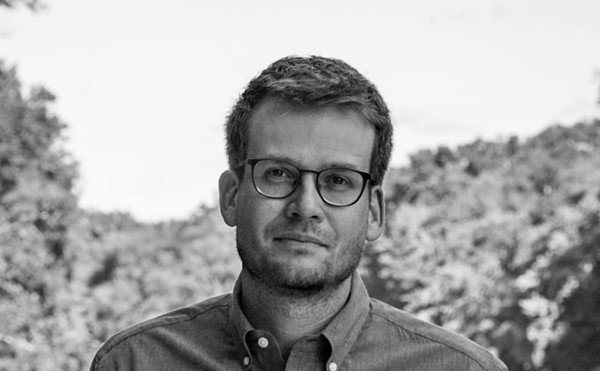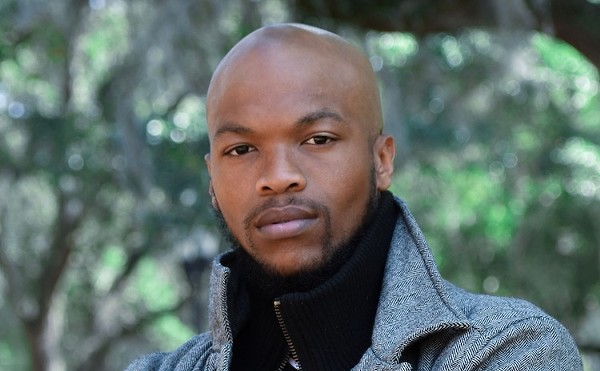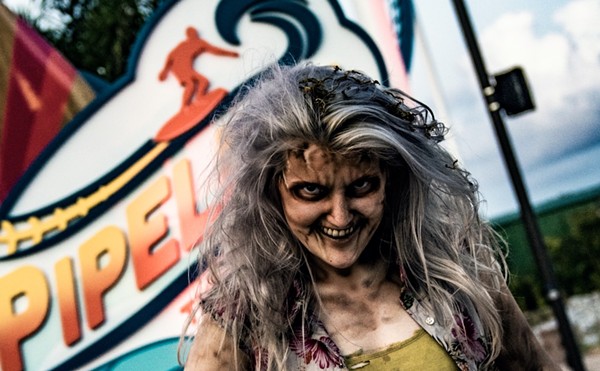Bryce Hammond
… all new works
Reception 7 p.m.-9 p.m.
Friday, May 1
Exhibit through June 11
Millenia Fine Art
555 S. Lake Destiny Drive
407-304-8100
www.milleniafineart.com
Free
Walking into Bryce Hammond's New Smyrna Beach home is like walking right into one of the paintings in the one-man exhibit that's set for a May 1 opening at Millenia Fine Art. Walls are the same deep, intense colors Hammond used in "The Tenant Rumor (The 18th Day)" and "Everything Was Closed in Coney Island," and a similar sense of jumbled planes and perspective lines is disorienting at first. Most of the dozen or so works leaning against those olive-green or brick-red or mustard-yellow walls are so new that Hammond was still comparing their painted versions to his own interior visions a couple of weeks ago.
But one at a time, he hung his paintings on a blank dining-room wall, and they dominated the space with their bold imagery and, paradoxically, ghostly, layered meanings.
"This came from a napkin I drew on at an airport in Jackson, Miss.," Hammond says, his eyes on "Everything Was Closed in Coney Island" and its dizzying angles and graffiti — some fresh and some faded. "I had been visiting friends and I saw it. I knew I wanted to put in the Cyclone, and that I wanted a bed but I was completely boring, so I added those red poles and then the wires attached to them."
That made all the difference, and the image that Hammond saw in his mind's eye needed only to be painted — in a patient process that takes about 100 hours, including coining titles that he says are "fun for me." In fact, despite drawing on his years as a kid in New Smyrna Beach and college years at Furman University, where he fell in love with art history and, especially, the mathematical precision of the Renaissance's one-point perspective, it's all fun for Hammond — that's how he shaped his life.
And, of course, the art that is his life.
"I love perspective," he says. "If I don't put a hole in the canvas to show where all the lines come together — the vanishing point — I put it somewhere else when I'm in the studio. And there, the crummier the place, the better it is to paint," says Hammond, turning to "Day One of the Brit-Rock Processional," with its crisply delineated Salisbury Cathedral arches and crumbling concert posters on weathered walls.
"Look how the painting drops out here," he says, pointing to the hot-hued stripes continuing past Gothic cathedral arches that suddenly stop, floating on thin air against the striped plane. "The shadow is seen from this dot, and it acts as a point of entry — I have a lot of points of entry, to draw people into the paintings. I put a Chinese being into an English painting because it was strong, and I used the stripes to point out that the Gothic arches stop.
"I did know what it would look like," says Hammond, his platinum-blond hair standing on end and paying perpetual homage to his years in tough sections of New York in the '90s, tagging and working with rival gang members on graffiti. Those projects sometimes ended with terrifying results that helped him decide to return to his hometown and settle down with a family that now includes his wife and two children. It's in the time between the start and close of the school day that he paints in the tool shed in his small home's backyard.
Prefab cookie-cutter on the outside, inside you see a small window unit that cools in summer, the little heater, the drywall that partly covers the insulation that came along only after a sweltering summer. Most of all, you see the painting wall, this one lit by incandescent floods and surrounded by drips, spatters, taped images that help with one area or another, and the latest work: a gigantic sardine can, lid curling back, and splashy, retro turquoise-and-gold tabletop adding jazzy color and shapes. "The paints are acrylics because this is Florida and it would take eight weeks for this to dry `if I used oils`, because I layer.
"My wife teaches, and I come here when everyone leaves for school," he says. "I come back around 8 at night and work until midnight, then do e-mails or shipping or something until about 1 a.m. — I'm too tired to work then."
That means about 10 hours a day go into painting — or, as Hammond puts it, constructing a painting.
"I like the idea of building — it's more that than ‘painting' because it's all planned out: what goes onto the canvas first, what's going to end up covered up and what's not, what's going to bleed though the acrylics," he says. "The planning and building come from my high-school years.
"I wanted to be an artist, but I also really liked science fairs. I was fourth in Florida's science fair competition in 1988; you really have to plan everything like you're doing a science-fair project, step-by-step, and I do," says Hammond. Factor in his other skills, then and now, and you have an artist who works on a schedule that makes "building" art a priority but that also includes surfing, skateboarding and an active family life — right down to styling the colors in the house, even the kitchen drawers.
That day, some were turquoise and others were a stern, rich blue — not too different, against the interior walls and midnight-blue countertops, from the hues in "Coney Island" and other imaginary, but dazzlingly lucid visionary urbanscapes.
"I think I'm going with the blue," Hammond says, distracted momentarily from which of his paintings need tweaking — titles, maybe, or tones — before going on to the latest and most local of his many solo shows. "It feels right."
[email protected]

















